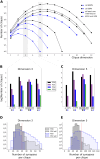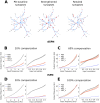The impact of Parkinson's disease on striatal network connectivity and corticostriatal drive: An in silico study
- PMID: 39735495
- PMCID: PMC11674317
- DOI: 10.1162/netn_a_00394
The impact of Parkinson's disease on striatal network connectivity and corticostriatal drive: An in silico study
Abstract
Striatum, the input stage of the basal ganglia, is important for sensory-motor integration, initiation and selection of behavior, as well as reward learning. Striatum receives glutamatergic inputs from mainly cortex and thalamus. In rodents, the striatal projection neurons (SPNs), giving rise to the direct and the indirect pathway (dSPNs and iSPNs, respectively), account for 95% of the neurons, and the remaining 5% are GABAergic and cholinergic interneurons. Interneuron axon terminals as well as local dSPN and iSPN axon collaterals form an intricate striatal network. Following chronic dopamine depletion as in Parkinson's disease (PD), both morphological and electrophysiological striatal neuronal features have been shown to be altered in rodent models. Our goal with this in silico study is twofold: (a) to predict and quantify how the intrastriatal network connectivity structure becomes altered as a consequence of the morphological changes reported at the single-neuron level and (b) to investigate how the effective glutamatergic drive to the SPNs would need to be altered to account for the activity level seen in SPNs during PD. In summary, we predict that the richness of the connectivity motifs in the striatal network is significantly decreased during PD while, at the same time, a substantial enhancement of the effective glutamatergic drive to striatum is present.
Keywords: Computational modeling; Directed cliques; Network higher order connectivity; Neuronal degeneration model; Parkinson’s disease; Striatum; Topological data analysis.
Plain language summary
This in silico study predicts the impact that the single-cell neuronal morphological alterations will have on the striatal microcircuit connectivity. We find that the richness in the topological striatal motifs is significantly reduced in Parkinson’s disease (PD), highlighting that just measuring the pairwise connectivity between neurons gives an incomplete description of network connectivity. Moreover, we predict how the resulting electrophysiological changes of striatal projection neuron excitability together with their reduced number of dendritic branches affect their response to the glutamatergic drive from the cortex and thalamus. We find that the effective glutamatergic drive is likely significantly increased in PD, in accordance with the hyperglutamatergic hypothesis.
© 2024 Massachusetts Institute of Technology.
Conflict of interest statement
Competing Interests: The authors have declared that no competing interests exist.
Figures








Similar articles
-
Differential Synaptic Remodeling by Dopamine in Direct and Indirect Striatal Projection Neurons in Pitx3-/- Mice, a Genetic Model of Parkinson's Disease.J Neurosci. 2018 Apr 11;38(15):3619-3630. doi: 10.1523/JNEUROSCI.3184-17.2018. Epub 2018 Feb 26. J Neurosci. 2018. PMID: 29483281 Free PMC article.
-
The roles of surround inhibition for the intrinsic function of the striatum, analyzed in silico.Proc Natl Acad Sci U S A. 2023 Nov 7;120(45):e2313058120. doi: 10.1073/pnas.2313058120. Epub 2023 Nov 3. Proc Natl Acad Sci U S A. 2023. PMID: 37922329 Free PMC article.
-
Cholinergic Interneurons Amplify Thalamostriatal Excitation of Striatal Indirect Pathway Neurons in Parkinson's Disease Models.Neuron. 2019 Feb 6;101(3):444-458.e6. doi: 10.1016/j.neuron.2018.12.004. Epub 2019 Jan 15. Neuron. 2019. PMID: 30658860
-
Excitatory extrinsic afferents to striatal interneurons and interactions with striatal microcircuitry.Eur J Neurosci. 2019 Mar;49(5):593-603. doi: 10.1111/ejn.13881. Epub 2018 Mar 25. Eur J Neurosci. 2019. PMID: 29480942 Free PMC article. Review.
-
Differential striatal spine pathology in Parkinson's disease and cocaine addiction: a key role of dopamine?Neuroscience. 2013 Oct 22;251:2-20. doi: 10.1016/j.neuroscience.2013.07.011. Epub 2013 Jul 16. Neuroscience. 2013. PMID: 23867772 Free PMC article. Review.
References
LinkOut - more resources
Full Text Sources
